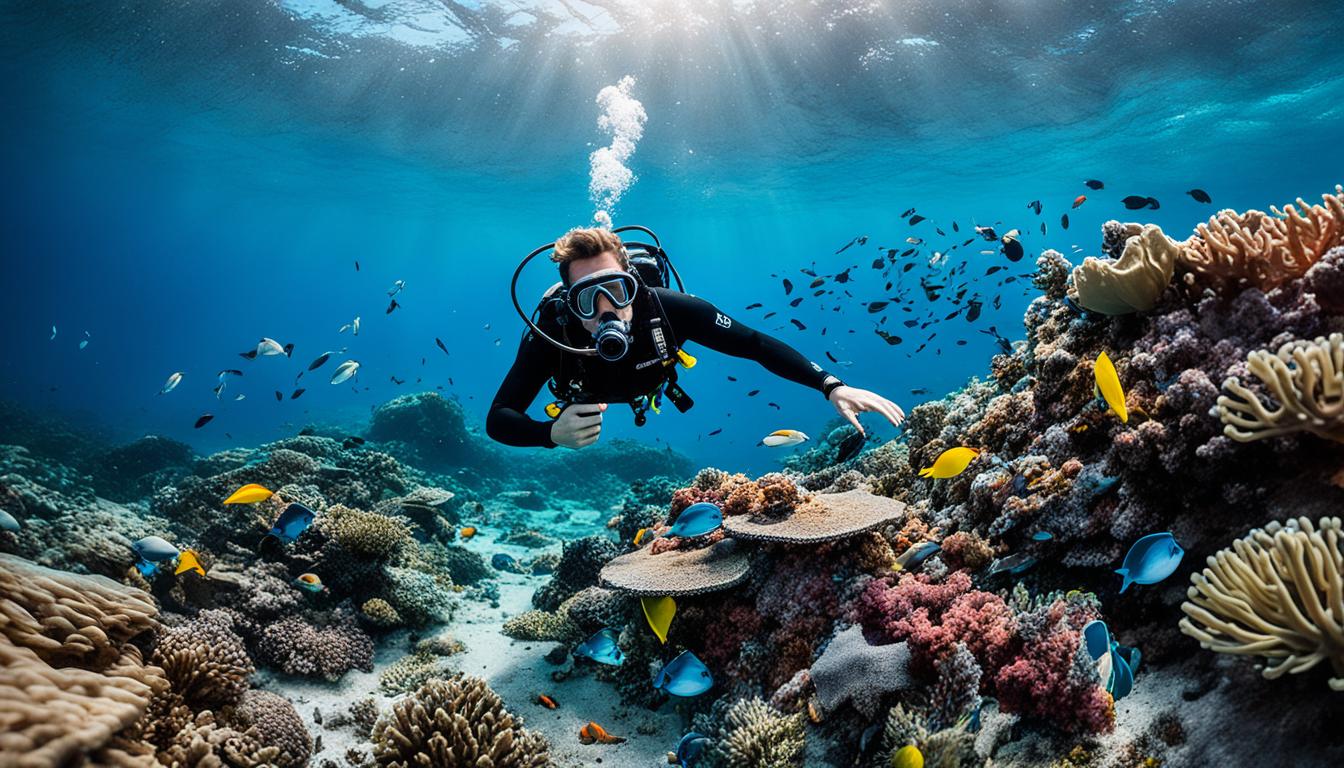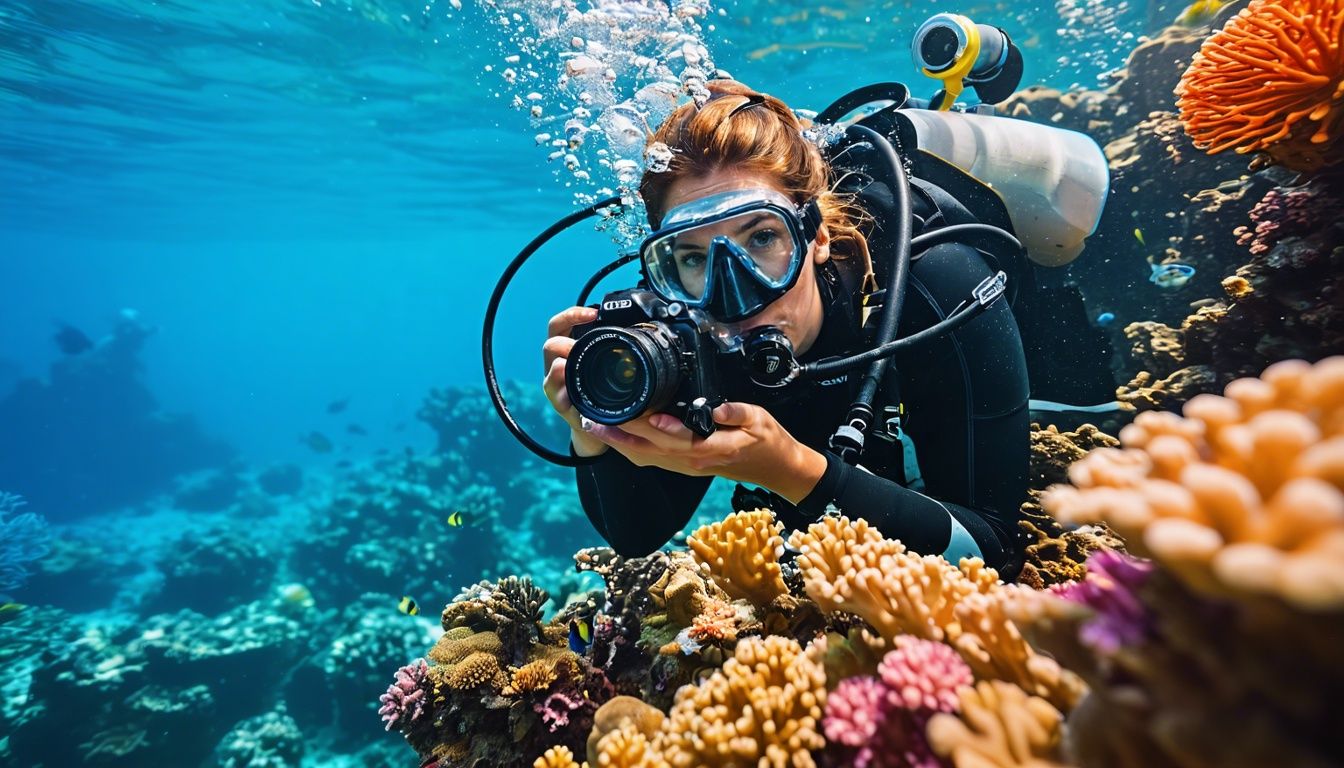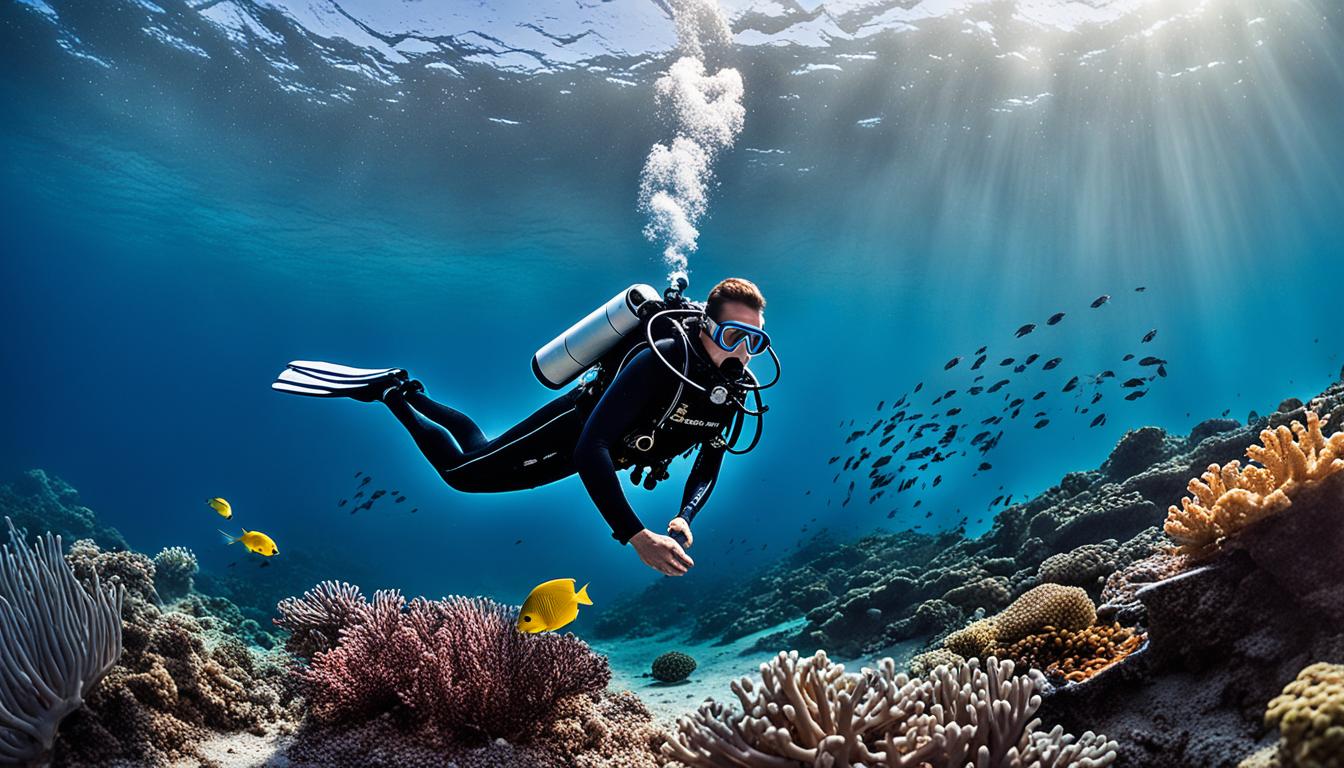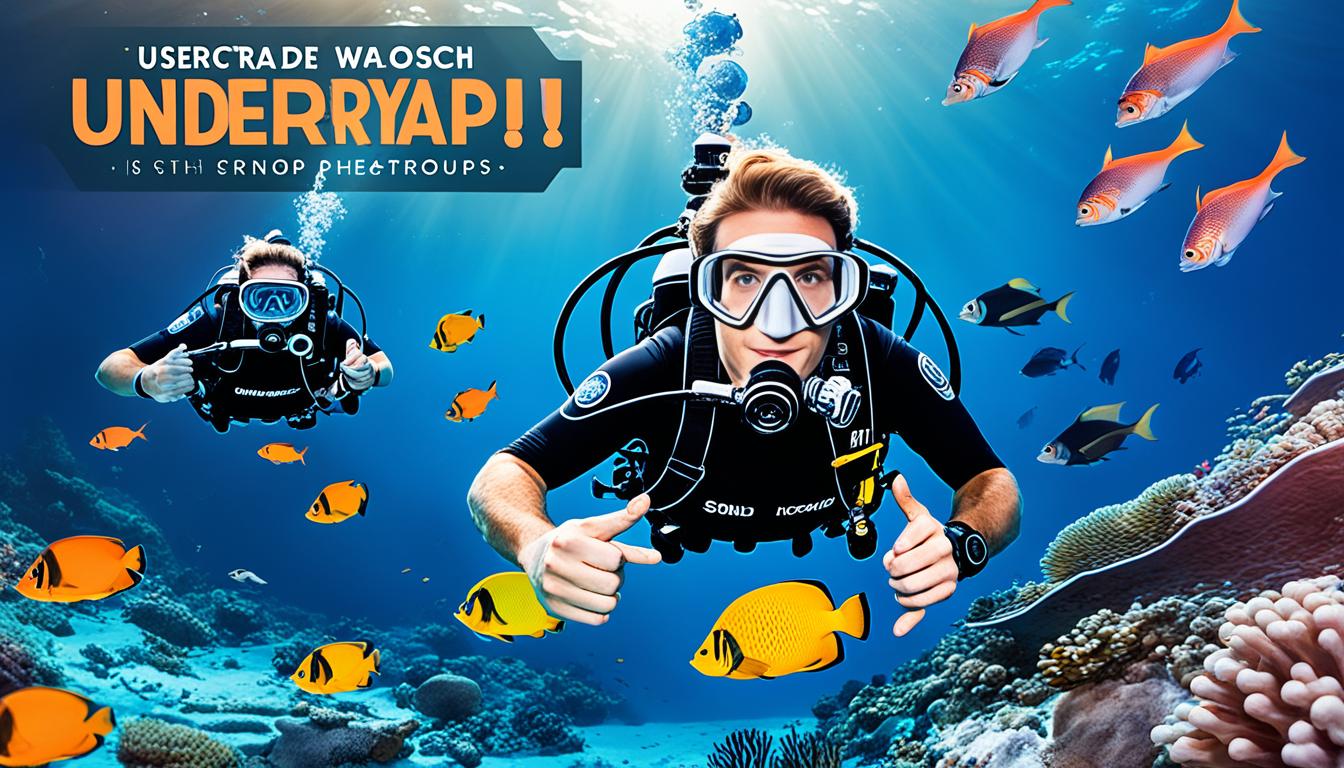Underwater photography is an exciting and captivating activity that allows us to capture the beauty and wonder of the marine world. However, as we immerse ourselves in this art form, it is important to be mindful of the ethical considerations and minimize our environmental impact. Responsible underwater photography not only preserves the delicate ecosystems we explore but also contributes to the long-term sustainability of our oceans.
As the popularity of underwater photography continues to grow, so does the need to address the potential harm it can cause. Studies have shown that photographers can unintentionally cause more damage to coral reefs and marine life than divers without cameras. Poor buoyancy control, chasing after subjects, and touching marine life can lead to stress and harm to underwater species.
Key Takeaways:
- Underwater photography brings economic benefits and supports scientific research and conservation efforts.
- Poor buoyancy control and goal-driven behavior can cause damage to coral reefs and marine life.
- Mastering buoyancy skills and using stable equipment can minimize damage to fragile marine life.
- Respecting marine life by not chasing subjects or touching marine creatures reduces stress and harm.
- Ethical considerations include avoiding staged images and minimizing the use of flash to minimize stress on marine life.
Minimizing Damage to Marine Life Through Buoyancy Control
Mastering buoyancy skills is crucial for underwater photographers to minimize damage to fragile marine life. Divers should ensure they have good buoyancy control and fundamental diving skills before using a camera underwater.
When underwater, it is important to be mindful of the delicate ecosystem and avoid accidental collisions with branching corals and anemones. These fragile organisms can be easily damaged by careless movements.
To further protect marine life, photographers can utilize an underwater tripod for stable shots instead of lying on the seabed. This prevents unintentional harm to critters and their habitats.
By being cautious and aware of their surroundings, photographers can enjoy capturing the beauty of underwater landscapes while avoiding any unnecessary damage to the environment.
Underwater Tripod for Stable Shots
| Benefits of Using an Underwater Tripod | Example |
|---|---|
| Stable Shots | |
| Avoiding Seabed Damage | |
| Quick and Easy Setup |
Using an underwater tripod provides several advantages for underwater photographers. Firstly, it allows for stable shots, ensuring that the images are sharp and in focus. By minimizing camera shake, photographers can capture the intricate details of marine life without any blurriness.
Additionally, using an underwater tripod helps avoid damage to the seabed. By not lying on the fragile ecosystem, photographers can prevent unintentional destruction and preserve the delicate balance of underwater habitats.
Lastly, underwater tripods are quick and easy to set up, allowing photographers to capture their desired shots efficiently. With adjustable heights and versatile positioning, these tripods offer flexibility in composition and framing.
Overall, the use of an underwater tripod is a valuable tool for minimizing damage to marine life and ensuring responsible and sustainable underwater photography.
Respectful Behavior Towards Marine Life
Underwater photographers should prioritize the well-being of marine life and practice responsible behavior to ensure minimal stress and harm to the underwater environment.
When encountering marine creatures, it is important to remember that chasing after subjects that are trying to get away can cause distress. We should respect their need for space and refrain from pursuing them when they turn away.
Touching or attempting to touch marine life should be strictly avoided. Slow-moving creatures like seahorses and frogfish rely on camouflage and can be easily stressed by human interference.
To ensure a comfortable environment for marine life, it is recommended to approach slowly, allowing the animals to adjust to our presence. Taking test shots before capturing the perfect image and giving subjects space to move can greatly reduce stress.
By following these guidelines and behaving responsibly, we can make a positive impact on underwater ecosystems and enjoy the beauty of marine life without causing harm.
Ethical Considerations in Underwater Photography
When practicing underwater photography, it is essential for us as photographers to be mindful of ethical considerations. Upholding high ethical standards not only ensures the integrity of our work but also promotes responsible behavior towards the marine environment. By adhering to ethical guidelines, we can capture the true beauty of underwater ecosystems while minimizing our impact on marine life.
“Introducing litter or bait to create sensational images should be avoided as it promotes harmful behavior and creates a false impression of the underwater world.”
One important ethical consideration is to avoid staging or altering scenes underwater. Our primary aim should be to capture the natural state of the marine environment. By refraining from introducing artificial elements or altering the surroundings, we can present an authentic depiction of the underwater world and foster a deeper appreciation for its wonders.
“Flash photography should be used sparingly, especially around light-sensitive species like seahorses.”
Another important aspect of ethical underwater photography is the minimal use of flash. Flash photography can startle and disorientate light-sensitive species such as seahorses and other nocturnal creatures. By using flash judiciously, only when necessary, we can minimize disturbance and ensure the well-being of marine life.
“Taking test shots away from the subject and limiting the number of photos taken can minimize stress on marine life.”
In our quest to capture the perfect shot, it’s crucial to remember that marine life should always come first. Taking test shots away from the subject and minimizing the number of photos taken can reduce stress on underwater species. This allows us to appreciate the beauty of nature without causing unnecessary harm or disturbance.
Tips for Ethical Underwater Photography
- Avoid staging scenes or altering the marine environment for photography purposes.
- Use flash sparingly, especially around light-sensitive species.
- Prioritize the well-being of marine life by taking test shots away from the subject.
- Limit the number of photos taken to minimize disturbance.
| Ethical Considerations | Tips |
|---|---|
| Avoid staging or altering scenes | Present the natural state of the marine environment to create an authentic representation |
| Minimal use of flash | Use flash judiciously, especially around light-sensitive species like seahorses |
| Limit stress on marine life | Take test shots away from the subject and minimize the number of photos taken |
By following these ethical guidelines, we can showcase the beauty of the underwater world while respecting and preserving the delicate balance of marine ecosystems. Let’s prioritize the safety and well-being of both ourselves as photographers and the wildlife we encounter, ensuring that our underwater photography contributes to the conservation and appreciation of our oceans.
Conclusion
Responsible underwater photography and maintaining ethical standards are crucial for supporting sustainable behavior and protecting marine life. By adhering to guidelines that minimize environmental impact, we can ensure that our passion for underwater photography does not harm the fragile ecosystems we explore. It is important for all divers, underwater photographers, organizational leaders, and dive centers to join forces in promoting and supporting sustainable practices.
As a community, we must set ethical standards and raise awareness about the impact of our actions on the underwater world. By educating ourselves and others about responsible behavior, we can foster a culture of respect for marine life. By prioritizing the well-being of the ecosystems we photograph, we contribute to their long-term preservation.
Supporting efforts to preserve underwater ecosystems is essential. Whether it’s participating in clean-up initiatives, collaborating with marine conservation organizations, or funding research projects, we can actively contribute to the protection of our oceans. Together, we can make a positive impact and ensure that future generations can enjoy the beauty of the underwater world.
FAQ
What are some ethical considerations when practicing underwater photography?
When practicing underwater photography, it is important to prioritize the well-being of marine life and practice respectful behavior. This includes not chasing after subjects that are trying to get away, avoiding touching or trying to touch marine creatures, and refraining from altering or staging scenes to create a false impression. By following ethical guidelines, photographers can minimize their impact on the environment and create a comfortable environment for marine life.
How can underwater photographers minimize damage to fragile marine life?
Underwater photographers can minimize damage to fragile marine life by mastering buoyancy skills and ensuring good buoyancy control and diving skills before using a camera underwater. They should be careful not to accidentally swim into or hit branching corals or other delicate marine organisms. Using an underwater tripod for stable shots instead of lying on the seabed can also prevent unintentional harm to marine life. Being cautious and aware of their surroundings will help photographers enjoy underwater photography without causing harm.
What should underwater photographers avoid to reduce stress on marine life?
To reduce stress on marine life, underwater photographers should avoid chasing after subjects that are trying to get away. It is also critical to refrain from touching or trying to touch marine creatures, particularly slow-moving animals like seahorses and frogfish that rely on camouflage. By approaching slowly, taking test shots, and giving subjects space to move, photographers can create a comfortable environment for marine life and avoid causing unnecessary stress.
What ethical guidelines should underwater photographers follow?
Underwater photographers should strive to capture the reality of what they see underwater and avoid staging or altering scenes. Introducing litter or bait to create sensational images should be avoided, as it promotes harmful behavior and creates a false impression of the underwater world. Flash photography should be used sparingly, especially around light-sensitive species. Taking test shots away from the subject and limiting the number of photos taken can minimize stress on marine life. By prioritizing the safety and well-being of both the photographer and the wildlife, ethical underwater photography can be achieved.
How can underwater photographers contribute to the protection of marine life?
By adhering to ethical guidelines and practicing responsible behavior, underwater photographers can contribute to the protection of marine life. It is important for divers, organizational leaders, and dive centers to support and promote sustainable behavior in underwater photography. By setting ethical standards, raising awareness, and supporting efforts to preserve underwater ecosystems, the underwater photography community can make a positive impact on the environment.
Does Underwater Photography Have a Negative Eco-Impact, Especially When Focusing on Reflections and Silhouettes?
When it comes to underwater photography techniques, capturing reflections and silhouettes can create stunning images. However, there is a concern about the negative eco-impact of this practice. The use of artificial lighting and disturbance of marine life can have detrimental effects on the underwater environment.




